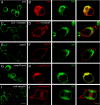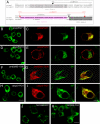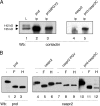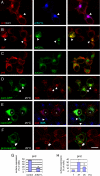PGY repeats and N-glycans govern the trafficking of paranodin and its selective association with contactin and neurofascin-155
- PMID: 17093057
- PMCID: PMC1751330
- DOI: 10.1091/mbc.e06-06-0570
PGY repeats and N-glycans govern the trafficking of paranodin and its selective association with contactin and neurofascin-155
Abstract
Formation of nodes of Ranvier requires contact of axons with myelinating glial cells, generating specialized axo-glial subdomains. Caspr/paranodin is required for the formation of septate-like junctions at paranodes, whereas the related caspr2 is essential for the organization of juxtaparanodes. The molecular mechanisms underlying the segregation of these related glycoproteins within distinct complexes are poorly understood. Exit of paranodin from the endoplasmic reticulum (ER) is mediated by its interaction with F3/contactin. Using domain swapping with caspr2, we mapped a motif with Pro-Gly-Tyr repeats (PGY) in the ectodomain of paranodin responsible for its ER retention. Deletion of PGY allows cell surface delivery of paranodin bypassing the calnexin-calreticulin quality control. Conversely, insertion of PGY in caspr2 or NrCAM blocks these proteins in the ER. PGY is a novel type of processing signal that compels chaperoning of paranodin by contactin. Contactin associated with paranodin is expressed at the cell surface with high-mannose N-glycans. Using mutant CHO lines altered in the processing of N-linked carbohydrates, we show that the high-mannose glycoform of contactin strongly binds neurofascin-155, its glial partner at paranodes. Thus, the unconventional processing of paranodin and contactin may determine the selective association of axo-glial complexes at paranodes.
Figures









Similar articles
-
The paranodal complex of F3/contactin and caspr/paranodin traffics to the cell surface via a non-conventional pathway.J Biol Chem. 2003 Nov 28;278(48):48339-47. doi: 10.1074/jbc.M309120200. Epub 2003 Sep 12. J Biol Chem. 2003. PMID: 12972410
-
Neurofascin is a glial receptor for the paranodin/Caspr-contactin axonal complex at the axoglial junction.Curr Biol. 2002 Feb 5;12(3):217-20. doi: 10.1016/s0960-9822(01)00680-7. Curr Biol. 2002. PMID: 11839274
-
The glycosylphosphatidyl inositol-anchored adhesion molecule F3/contactin is required for surface transport of paranodin/contactin-associated protein (caspr).J Cell Biol. 2000 Apr 17;149(2):491-502. doi: 10.1083/jcb.149.2.491. J Cell Biol. 2000. PMID: 10769038 Free PMC article.
-
F3/contactin, a neuronal cell adhesion molecule implicated in axogenesis and myelination.Biol Cell. 2002 Oct;94(6):327-34. doi: 10.1016/s0248-4900(02)00006-0. Biol Cell. 2002. PMID: 12500940 Review.
-
Transmembrane scaffolding proteins in the formation and stability of nodes of Ranvier.Biol Cell. 2003 Oct;95(7):447-52. doi: 10.1016/s0248-4900(03)00073-x. Biol Cell. 2003. PMID: 14597262 Review.
Cited by
-
The mouse F3/contactin glycoprotein: structural features, functional properties and developmental significance of its regulated expression.Cell Adh Migr. 2009 Jan-Mar;3(1):53-63. doi: 10.4161/cam.3.1.7462. Epub 2009 Jan 19. Cell Adh Migr. 2009. PMID: 19372728 Free PMC article. Review.
-
Contactins: emerging key roles in the development and function of the nervous system.Cell Adh Migr. 2009 Jan-Mar;3(1):64-70. doi: 10.4161/cam.3.1.7764. Epub 2009 Jan 6. Cell Adh Migr. 2009. PMID: 19262165 Free PMC article. Review.
-
Progressive disorganization of paranodal junctions and compact myelin due to loss of DCC expression by oligodendrocytes.J Neurosci. 2014 Jul 16;34(29):9768-78. doi: 10.1523/JNEUROSCI.0448-14.2014. J Neurosci. 2014. PMID: 25031414 Free PMC article.
-
Structural Perspectives on Extracellular Recognition and Conformational Changes of Several Type-I Transmembrane Receptors.Front Mol Biosci. 2020 Aug 7;7:129. doi: 10.3389/fmolb.2020.00129. eCollection 2020. Front Mol Biosci. 2020. PMID: 32850948 Free PMC article. Review.
-
Maintenance of axo-oligodendroglial paranodal junctions requires DCC and netrin-1.J Neurosci. 2008 Oct 22;28(43):11003-14. doi: 10.1523/JNEUROSCI.3285-08.2008. J Neurosci. 2008. PMID: 18945908 Free PMC article.
References
-
- Baldwin T. A., Ostergaard H. L. The protein-tyrosine phosphatase CD45 reaches the cell surface via golgi-dependent and -independent pathways. J. Biol. Chem. 2002;277:50333–50340. - PubMed
-
- Bhat M. A., et al. Axon-glia interactions and the domain organization of myelinated axons requires neurexin IV/Caspr/Paranodin. Neuron. 2001;30:369–383. - PubMed
-
- Bichet D., Cornet V., Geib S., Carlier E., Volsen S., Hoshi T., Mori Y., De Waard M. The I-II loop of the Ca2+ channel alpha1 subunit contains an endoplasmic reticulum retention signal antagonized by the beta subunit. Neuron. 2000;25:177–190. - PubMed
-
- Bonnon C., Goutebroze L., Denisenko-Nehrbass N., Girault J. A., Faivre-Sarrailh C. The paranodal complex of F3/contactin and caspr/paranodin traffics to the cell surface via a non-conventional pathway. J. Biol. Chem. 2003;278:48339–48347. - PubMed
-
- Boyle M. E., Berglund E. O., Murai K. K., Weber L., Peles E., Ranscht B. Contactin orchestrates assembly of the septate-like junctions at the paranode in myelinated peripheral nerve. Neuron. 2001;30:385–397. - PubMed
Publication types
MeSH terms
Substances
LinkOut - more resources
Full Text Sources
Research Materials
Miscellaneous

